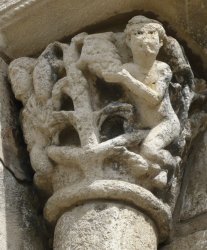Thuret
Photo: Ella Rozett. Notice the lotus blossoms at her feet, an Indian symbol of enlightenment.
Our Lady of Thuret
The Virgin-Warrior of the Crusades
In the village church. Thuret is between Vichy and Clermont-Ferrand, Puy-de-Dome department, Auvergne region, 17th century replacement of the 13th century original.
In the 13th century the seventh Crusade (1248-1254) was preached in the sanctuary of the famous Black Madonna of Le-Puy-en-Velay, in the presence of King Louis IX and the feudal lord of Thuret. The latter must have gone home with a copy of this Madonna in order to instill zeal for the "Holy War" in his subjects. All we know is that since that time a Black Virgin who looks just like the one that presently resides behind the main altar of Le-Puy, is honored in Thuret under the titles Virgin of the Crusades or Virgin-Warrior.
Several visitors have attested to the magical-mystical power of her church. Strange esoteric, masonic and pre-Christian symbols abound in this church. Many of them are explained in a photocopied booklet for sale in the church. It is René Chabrillat's "Thuret: its church mediates Christian initiation".
The author explains what the monks who built this church meant to express: They were well aware of all the ancient wisdom traditions from Atlantis, Egypt, India, and Druidic France. All that is good in those teachings and which leads to God, they have incorporated into their Christian mysteries and represented in their church.
What is to be left outside the Christian Church is the God Dionysius with his orgiastic debaucheries. He is a lonely figure remembered outside, over the North entrance. As his followers pick grapes, phallic branches press into their groins.
Over the South entrance, near Christ, there is the Fool somersaulting and holding a concave mirror. He warns the initiates not to enter the sacred space from the wrong direction. Perhaps this means, look at yourself in the mirror of your conscience and enter the Way only with the right determination and motivation.
Inside the church one finds the holy water stoup which shows a horse biting its tail. As when a snake is shown biting its tail, so this horse too symbolizes eternity. But this horse also denotes the Gallic mare-goddess Epona. She was a nurturing mother-goddess of fertility, depicted as a white mare, pure, heroic, self-sacrificing. She became the patron of horses and all who work with them, e.g. the Roman cavalry. From being a guide to all who traveled by horse, she was promoted to leading the deceased on their last great journey through the underworld. Chabrillat explains that her presence on the holy water stoup reminds us that this water is meant to make us pure like Epona so that we can approach God. (p.25)
A Merovingian sarcophagus reminds us of the legend that this dynasty descends from a supposed union of Jesus and Mary Magdalene. Though an older legend wants to trace the 'blue blood' of this dynasty to another set of human and divine parents. It states that the 5th century legendary Merovech, founder of the Merovingians, was the son of King Clodio's wife and a fabulous water creature related to the god Neptune. Before getting too exited about the "bloodline" of Jesus and Mary Magdalene, it might behoove us to remember that almost all royalty (whether European, Asian, or African) claims mythical or heavenly descent. Hence the concept of 'blue blood'. As in the case of the Merovingians, the idea is always used to justify the domination of others. Descending from Jesus seemed like the perfect reason to need to rule the world, which is precisely what the Merovingians had in mind.
Note:
Ean Begg is very intrigued by this legend. He describes this dynasty as spiritual, but also acknowledges its political ambitions. Pp. 13-14 and 145-6. Jacque Huynen on the other hand characterizes the Merovingians as illiterate barbarians with a simplistic view of Christianity, which they imposed on others by the sword. They ruled France after the Germanic tribes had plunged Europe into the Dark Ages and put an end to the relative harmony that had been reached between Roman Christianity and Celtic religion. "L'Enigme des Vierges Noires", pp. 56-57 and 61.





